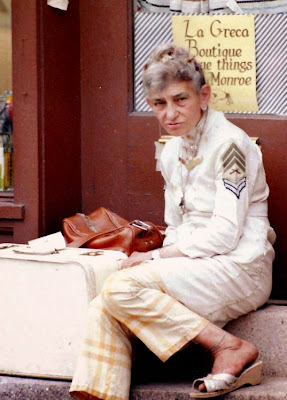 |
| Photo taken of Stella Paris by a Detroit Policeman |
Stella was a modern day Cassandra that nobody wanted to listen to. Over forty years ago, whenever my friends and I would go to Greektown for dinner or shop at Trappers' Alley, Stella was often ranting something in Greek or broken English at the top of her lungs at all hours of the night. Stella's piercing voice would echo off the brick buildings. She was impossible to ignore. Because she was a permanent fixture on Monroe Street, we quipped that she was being paid by the restaurant owners to provide local color for the Greek neighborhood.
Several newspaper accounts at the time of her death list Stella Paris' age at ninety-five or older. No birth certificate, citizenship, or immigration documentation exists for her, so she was denied public assistance. Stella is believed to have been born on the Greek island of Samos.
Doug Guthrie, writing for The Detroit News on January 21, 2011, discovered that "(Stella) had come to this country in 1938 through an arranged marriage to restaurant owner John Perris. She raised three sons and never wanted to learn English (but she spoke broken English of necessity). Stella was four feet, ten inches tall and very trim. She passed away from a heart condition. Stella's body was laid out at Annunciation Greek Orthodox Cathedral on East Lafayette Blvd.
In life, Stella suffered from mental illness and the scourge of schizophrenia. She had family who tried to take her in, but she wanted to be in Greektown where she felt comfortable, even when sleeping outside contending with the weather and other aggressive street people. She carried a nightstick for her protection, given to her by the police at the12th precinct downtown. "The Greek community took care of her by giving her food, shelter, and love," said Frank Becsi. "Stella is buried at Woodmere Cemetery."
"Stella was a blessing to me," says Shelley Rigney, someone who remembers her fondly. "I was young and she would always tell the 'Wolf' types not to bother me because my Momma knew Jack Tocco (Detroit Mafia Don) & my Pappa was a big crazy Irishman & I was the only baby girl in a house full of Big Boys. She would laugh and tell me, 'Ya justa keep walkin'. Don't you let any of that Trash even stick to your shoe.' God bless her sweet soul & kind heart... I still have ribbons and all the things she gave me."
Stella led the hard life of a homeless street person. Even when she was in her fifties, she looked much older than she was. A retired Detroit policeman who wishes not to be identified walked the Greektown beat for years. He tells a more sobering, less romantic story of Stella's street life.
"(Stella) claimed to be some sort of Greek princess, or that her late husband was the king of Greece, or some similar story.... She would hear voices and stand on the street corner and yell at the voices... you could hear her half a mile away on a calm day.
"She was your basic homeless bag lady, and unfortunately, her mind was not all there.... Stella's favorite motel was police headquarters at 1300 Beaubien, just up the street from Greektown. Some (of the officers) took her in as a mascot, providing her with some old marksmanship badges, chevrons, and a nightstick (billy club) that she carried faithfully....
 |
| Stella on the street. |
Detroit policewoman Cynthia Hill said, "From our perspective, she never meant any harm. When I was working as a teenage police cadet, I noticed the officers let her sleep in the basement (of police headquarters) and bathe in our sinks in the women's restroom on the first floor. At first, she scared me. They told me, 'It's just Stella.' Later when I became an officer, I would see her on the street and feel the same way."
News of his mother's death came as a surprise to her seventy-year-old son, Anthony Perris of Livonia. He told The Detroit News that her life began on the streets when she was in her fifties. "The family assumed she had died fifteen years ago when she disappeared from Greektown," Perris said. "We didn't know that she had been ordered by a judge into an assisted care facility because she was brandishing a knife."
Stella Paris spent the last years of her life peacefully at the East Grand Nursing Home on East Grand Blvd. At the time, the facility desperately searched for any relative who could shed light on her immigration status. Because of the common misspelling of her real last name, the Perris family was never notified. Stella was indigent, so the nursing home took her under its protective care. But when Stella needed heart surgery, they were simply not in any position to pay for her hospital bills.
We have all seen homeless people in our communities. Some do their best to be unobtrusive or obsequious, while others rant and rave, wrestling with their personal demons. They are all desperate people living a tooth and nail existence. In our several encounters with Greektown Stella, my wife and I tried our best to avoid and not engage her in conversation because we didn't know what to expect. I regret that decision now.
Shelley Rigney laments, "Stella was a woman who was tossed aside by many, but she still managed to survive somehow. Now I wish I would have taken time for her. She had a lot to say and teach others."
Finding out about Greektown Stella's death brought it all back to me. Rather than our scorn and apathy, these people need acts of kindness and generosity, not only during the holiday season but throughout the entire year.
More on Stella can be found in this link: http://www.mlive.com/news/detroit/index.ssf/2010/01/greektown_stella_shouts_no_mor.html



